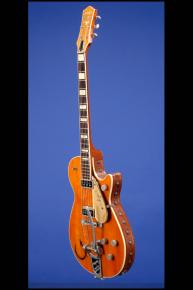The Solid Body Version of the Hollow 6120
This compact 13 1/4-inch-wide guitar weighs in at just 7.50 lbs. and has a very comfortable nut width of 1 11/16 inches and a scale length of 24 1/2 inches. Chambered mahogany body with a large "G" brand on the lower bass bout. The sides of the guitar are adorned with the same machine-engraved studded leather binding as the model 6130 "Round Up", which is inlaid into the sides and decorated with steersheads and cactus. One-piece mahogany neck with a medium-to-thick profile. Rosewood fretboard with 22 original 'thin' frets and inlaid mother-of-pearl block 'Cows-and-Cactus' position markers. Headstock with inlaid mother-of-pearl Gretsch "T-roof" logo and 'Steershead' inlay. Two-layer black over white plastic truss rod cover with three screws. Individual Grover StaTite open-back tuners with oval metal buttons. Two single-coil DeArmond (Gretsch Dynasonic) pickups, with outputs of 3.14k and 3.23k. Gold Lucite pickguard with pantograph-engraved Gretsch "T-roof" logo and "Chet Atkins" signature framed in a signpost (the signpost and signature highlighted in black). Four controls (two individual volume controls and master tone control in a triangular configuration on lower treble bout and master volume control on upper treble bout) plus three-way selector switch on upper bass bout. "Arrow-through-G" knobs with cross-hatch pattern on sides. The potentiometers are stamped "6151 498 444" (IRC October 1954). Original Gretsch rectangular white label inside control cavity, with the model number "6121" stamped in black, and the serial number "16958" stamped in red. Compensated aluminum bridge saddle on aluminum base with two height adjustment screws and unplated aluminum Bigsby B-3 vibrato tailpiece with pivoting arm. Gold-plated hardware. This guitar has its original aluminum nut. Apart from some minimal belt-buckle wear, a tiny amount of finish checking and some very slight varnish wear to the back of the neck this is a truly exceptional and totally original guitar in (9.25) near mint condition. Complete with the original jeweled brown leather Western strap. Housed in its original tweed fabric-covered hardshell case with red velvet lining (8.50).
The solid companion to the Chet Atkins Hollow Body debuted in 1954. The only differences between it and the Round-Up are standard the Chet Atkins model features: Bigsby B-3 vibrato tailpiece, non adjustable bridge, signature-signpost pickguard and a metal nut.
Despite the name, the Chet Atkins Solid Body had Gretsch's customary semi-solid 'chambered' construction.
"Since both the hollowbody and solid body Chet Atkins signature models were launched simultaneously for 1955, it is plausible that the factory was hurried into making a initial quantity of each to equitably fill orders after the first of the year. The result was that the first Chet Atkins production batch (#16450 - #16549) was comprised of approximately 75 hollowbody 6120 examples and 25 solidbody 6121 guitars. When examining the batching approach of the Brooklyn factory in the late 1950s, it becomes clear from the serial number data that the 6120 model production was typically planned in sequence with other 16" archtops, particularly after the the 1958 introduction of the 6119 and Anniversary models. From the start, however, the factory produced a few examples of the 6121 solidbody within many of the 6120 hollowbody batches. This was possibly an effort to insure consistent color finishes between the two related models. Other times this practice has occurred was when the White Penguin solidbody (model 6134) was periodically produced during batch runs of White Falcon archtops (model 6136). Presumably, like the Chet Atkins signature models, some dealers would market the two related models together, ordering examples of each. These occurrences might provide additional evidence to support the theory that the paint room controlled a lot of the production scheduling within the Gretsch factory. Once a certain pigment or stain was loaded, it seems that they went to great lengths to get all the guitars requiring that finish treatment through the system before having to wash up and go to another color. Throughout the hollowbody format's single-cutaway era, the 6121 solidbody model reflected very similar features to its respective 6120 littermates. Although increasingly rare after the 1960 model year, there have been specimens found as late as the 1962 model year complete with the double-cutaway body styling of the period" (Edward BALL. Gretsch 6120 The History of a Legendary Guitar, p. 79).
Translate:

















